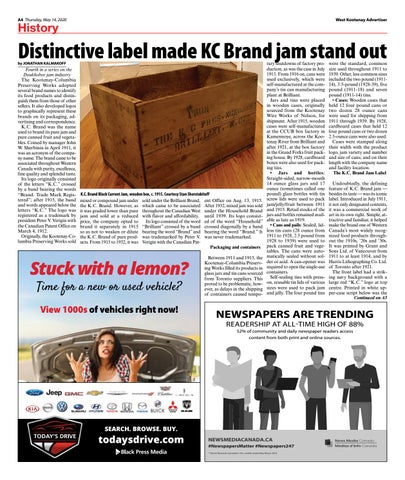A4 Thursday, May 14, 2020
West Kootenay Advertiser
History
Distinctive label made KC Brand jam stand out by JONATHAN KALMAKOFF
Fourth in a series on the Doukhobor jam industry The Kootenay-Columbia Preserving Works adopted several brand names to identify its food products and distinguish them from those of other sellers. It also developed logos to graphically represent these brands on its packaging, advertising and correspondence. K.C. Brand was the name used to brand its pure jam and pure canned fruit and vegetables. Coined by manager John W. Sherbinin in April 1911, it was an acronym of the company name. The brand came to be associated throughout Western Canada with purity, excellence, fine quality and splendid taste. Its logo originally consisted of the letters “K.C.” crossed by a band bearing the words “Brand. Trade Mark Registered”; after 1915, the band and words appeared below the letters “K.C.” The logo was registered as a trademark by president Peter V. Verigin with the Canadian Patent Office on March 4, 1912. Originally, the Kootenay-Columbia Preserving Works sold
K.C. Brand Black Current Jam, wooden box, c. 1915. Courtesy Stan Sherstobitoff mixed or compound jam under sold under the Brilliant Brand, ent Office on Aug. 13, 1915. the K.C. Brand. However, as which came to be associated After 1932, mixed jam was sold it was graded lower than pure throughout the Canadian West under the Household Brand jam and sold at a reduced with flavor and affordability. until 1939. Its logo consistprice, the company opted to Its logo consisted of the word ed of the word “Household” brand it separately in 1915 “Brilliant” crossed by a band crossed diagonally by a band so as not to weaken or dilute bearing the word “Brand” and bearing the word “Brand.” It the K.C. Brand of pure prod- was trademarked by Peter V. was never trademarked. ucts. From 1915 to 1932, it was Verigin with the Canadian PatPackaging and containers
Stuck with a lemon? Time for a new or used vehicle? View 1000s of vehicles right now!
Between 1911 and 1915, the Kootenay-Columbia Preserving Works filled its products in glass jars and tin cans sourced from Toronto suppliers. This proved to be problematic, however, as delays in the shipping of containers caused tempo-
rary shutdowns of factory production, as was the case in July 1913. From 1916 on, cans were used exclusively, which were self-manufactured at the company’s tin can manufacturing plant at Brilliant. Jars and tins were placed in wooden cases, originally sourced from the Kootenay Wire Works of Nelson, for shipment. After 1915, wooden cases were self-manufactured at the CCUB box factory in Kamennoye, across the Kootenay River from Brilliant and after 1921, at the box factory in the Grand Forks fruit packing house. By 1928, cardboard boxes were also used for packing tins. • Jars and bottles: Straight-sided, narrow-mouth 14 ounce glass jars and 17 ounce (sometimes called one pound) glass bottles with tin screw lids were used to pack jam/jelly/fruit between 1911 and 1915. Retail stocks of the jars and bottles remained available as late as 1919. • Cans and pails: Sealed, lidless tin cans (28 ounce from 1911 to 1928, 2.5 pound from 1928 to 1939) were used to pack canned fruit and vegetables. The cans were automatically sealed without solder or acid. A can-opener was required to open the single-use containers. Self-sealing tins with presson, reusable tin lids of various sizes were used to pack jam and jelly. The four pound tins
were the standard, common size used throughout 1911 to 1939. Other, less common sizes included the two pound (191114), 3.5-pound (1928-39), five pound (1911-18) and seven pound (1911-14) tins. • Cases: Wooden cases that held 12 four pound cans or two dozen 28 ounce cans were used for shipping from 1911 through 1939. By 1928, cardboard cases that held 12 four pound cans or two dozen 2.5-ounce cans were also used. Cases were stamped along their width with the product logo, jam variety and number and size of cans; and on their length with the company name and facility location. The K.C. Brand Jam Label Undoubtedly, the defining feature of K.C. Brand jam — besides its taste — was its iconic label. Introduced in July 1911, it not only designated contents, it was a commercial work of art in its own right. Simple, attractive and familiar, it helped make the brand one of Western Canada’s most widely recognized food products throughout the 1910s, ’20s and ’30s. It was printed by Grant and Sons Ltd. of Vancouver from 1911 to at least 1914, and by Harris Lithographing Co. Ltd. of Toronto after 1921. The front label had a striking navy background with a large red “K.C.” logo at top centre. Printed in white upper-case script below was the Continued on A5
NEWSPAPERS ARE TRENDING READERSHIP AT ALL-TIME HIGH OF 88% 52% of community and daily newspaper readers access content from both print and online sources.
SEARCH. BROWSE. BUY.
todaysdrive.com
NEWSMEDIACANADA.CA #NewspapersMatter #Newspapers247 * Totum Research; Canadians 18+, weekly readership, March 2019
